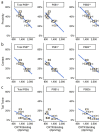Oxytocin receptor binding in the titi monkey hippocampal formation is associated with parental status and partner affiliation
- PMID: 33057124
- PMCID: PMC7560868
- DOI: 10.1038/s41598-020-74243-1
Oxytocin receptor binding in the titi monkey hippocampal formation is associated with parental status and partner affiliation
Abstract
Social cognition is facilitated by oxytocin receptors (OXTR) in the hippocampus, a brain region that changes dynamically with pregnancy, parturition, and parenting experience. We investigated the impact of parenthood on hippocampal OXTR in male and female titi monkeys, a pair-bonding primate species that exhibits biparental care of offspring. We hypothesized that in postmortem brain tissue, OXTR binding in the hippocampal formation would differ between parents and non-parents, and that OXTR density would correlate with frequencies of observed parenting and affiliative behaviors between partners. Subjects were 10 adult titi monkeys. OXTR binding in the hippocampus (CA1, CA2/3, CA4, dentate gyrus, subiculum) and presubiculum layers (PSB1, PSB3) was determined using receptor autoradiography. The average frequency of partner affiliation (Proximity, Contact, and Tail Twining) and infant carrying were determined from longitudinal observations (5-6 per day). Analyses showed that parents exhibited higher OXTR binding than non-parents in PSB1 (t(8) = - 2.33, p = 0.048), and that OXTR binding in the total presubiculm correlated negatively with Proximity (r = - 0.88) and Contact (r = - 0.91), but not Tail Twining or infant carrying. These results suggest that OXTR binding in the presubiculum supports pair bonding and parenting behavior, potentially by mediating changes in hippocampal plasticity.
Conflict of interest statement
The authors declare no competing interests.
Figures




References
Publication types
MeSH terms
Substances
Grants and funding
LinkOut - more resources
Full Text Sources
Medical
Miscellaneous

